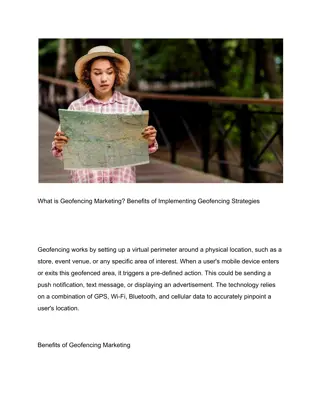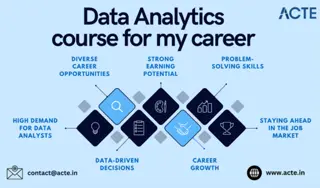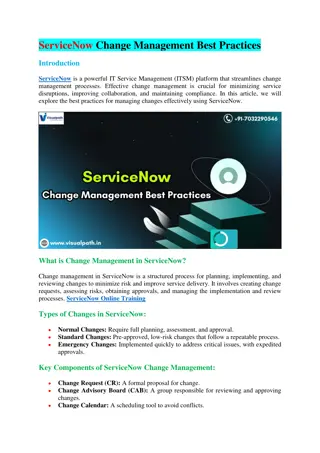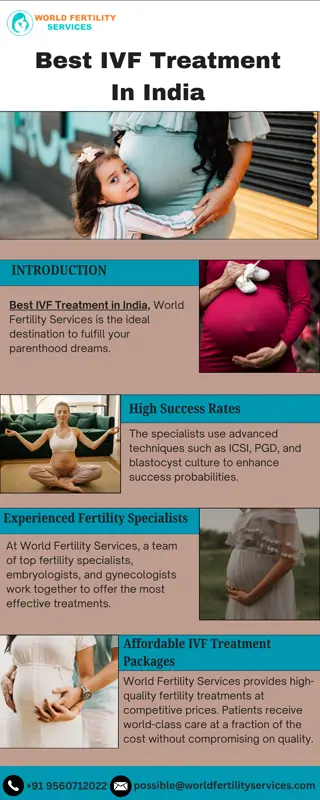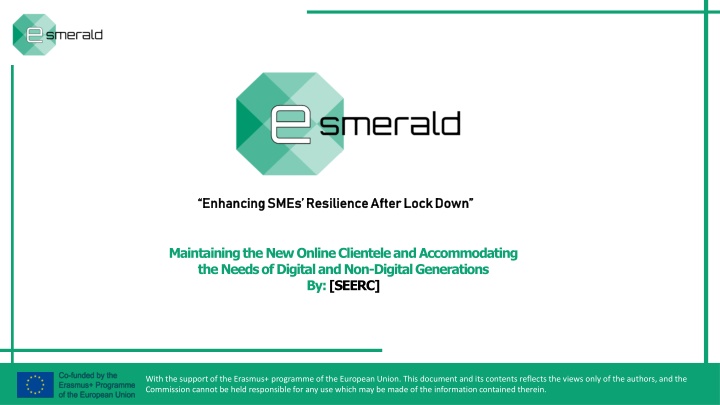
Enhancing SMEs Resilience Post-Lockdown: Strategies for Online Clientele and Generational Adaptation
Discover strategies to boost resilience in SMEs post-lockdown by maintaining new online clientele and catering to digital and non-digital generations. Learn about understanding online clientele needs, bridging generational gaps, attracting clients digitally, and facilitating non-digital client interactions.
Download Presentation

Please find below an Image/Link to download the presentation.
The content on the website is provided AS IS for your information and personal use only. It may not be sold, licensed, or shared on other websites without obtaining consent from the author. If you encounter any issues during the download, it is possible that the publisher has removed the file from their server.
You are allowed to download the files provided on this website for personal or commercial use, subject to the condition that they are used lawfully. All files are the property of their respective owners.
The content on the website is provided AS IS for your information and personal use only. It may not be sold, licensed, or shared on other websites without obtaining consent from the author.
E N D
Presentation Transcript
Enhancing SMEs Resilience After Lock Down Enhancing SMEs Resilience After Lock Down Maintaining the NewOnline Clienteleand Accommodating the Needs of Digital and Non-Digital Generations By: [SEERC] With the support of the Erasmus+ programme of the European Union. This document and its contents reflects the views only of the authors, and the Commission cannot be held responsible for any use which may be made of the information contained therein.
OBJECTIVES AND GOALS OBJECTIVES AND GOALS At the end of this module you will be able to: Objective 1: Understand the needs of today s online clientele Objective 2: Work through Generational differences Objective 3: Attract new clients through digital means Objective 4: Make things easier for non-digital clients With the support of the Erasmus+ programme of the European Union. This document and its contents reflects the views only of the authors, and the Commission cannot be held responsible for any use which may be made of the information contained therein.
UNIT 1: UNIT 1: Understand the needs Understand the needs of today s online clientele SECTION 1.1.1: What are online clientele? of today s online clientele In just about every business today it is hard to find a client that is not in some way digitally connected (online)(. There are various forms of online customers: - - - - Pure online Pre-dominantly online Somewhat online Extremely limited online / digital presence An online customer is viewed as one whose primary mode of connection (marketing, customer service etc.) is through an online channel. They have limited in-person contact with their suppliers this has become much more prevalent through the pandemic. xxx With the support of the Erasmus+ programme of the European Union. This document and its contents reflects the views only of the authors, and the Commission cannot be held responsible for any use which may be made of the information contained therein.
UNIT 1: UNIT 1: Understand the needs Understand the needs of today s online clientele of today s online clientele SECTION 1.1.1: What are online clientele? The needs to online clientele include: - - - - - - Ease and convenience Clear customer interface (intuitive) Clear information (including pricing and delivery) Rapid response customer service Order anytime, anywhere, any device Level of personalization https://www.elasticpath.com/blog/Top-10-Things-Customers-Expect-from-Your-Online-Store https://www.statista.com/chart/7957/whats-important-to-the-online-shopper/ With the support of the Erasmus+ programme of the European Union. This document and its contents reflects the views only of the authors, and the Commission cannot be held responsible for any use which may be made of the information contained therein.
UNIT 1: UNIT 1: Work through generational differences Work through generational differences SECTION 1.2.1: Generational differences There are, arguably, six generations of online clientele in today s marketplace (dates of birth vary). Baby Boomers 1946 to 1964 Generation X (Lost Generation) 1965 1980 Digital immigrants Generation Y (Millennials) 1981 1995 Digital pioneers Generation Z 1997 2012 Digital Natives, have always known the internet Each generation is tending to look for different things in their online interactions. We will focus on Millennials (Generation Y:) and Generation Z given their purchasing power and the fact that there is abundant information available on them and they make up the majority of pure/pre-dominantly online customers identified earlier (together worth nearly $3 trillion) With the support of the Erasmus+ programme of the European Union. This document and its contents reflects the views only of the authors, and the Commission cannot be held responsible for any use which may be made of the information contained therein.
UNIT 2: UNIT 2: Work through generational differences Work through generational differences SECTION 1.2.2: Generation Y (Millennials) 1981 1995 Some of the unique characteristics of this generation as online consumers includes: - - - - - - Electronic word of mouth (EWOM) is very important (82% say critical ) Strongly prefer digital communication 90% extensively research before purchase Search for specialty products Health conscious, cook less, interested in wholesale Lower volume, higher quality purchases (branded) Various sources including: https://salesfloor.net/blog/generations-shopping-habits/ https://www.npd.com/news/thought-leadership/2018/10-ways-younger-and-older-millennials-shop-differently/ With the support of the Erasmus+ programme of the European Union. This document and its contents reflects the views only of the authors, and the Commission cannot be held responsible for any use which may be made of the information contained therein.
UNIT 2: UNIT 2: Work through generational differences Work through generational differences SECTION 1.2.3: Generation Z 1981 1995 Some of the unique characteristics of this generation as online consumers includes: - - - - When given the chance prefer face-to-face communication More likely to look at social media and brick and mortar locations than Generation Conscious of small producers (SMEs) Focus on sustainability in all aspects of the buying process Various sources including: https://elle.in/comparing-shopping-habits-of-gen-z-and- millenials/#:~:text=A%202021%20Survey%20Monkey%20report,and%20are%20less%20likely%20to With the support of the Erasmus+ programme of the European Union. This document and its contents reflects the views only of the authors, and the Commission cannot be held responsible for any use which may be made of the information contained therein.
UNIT 2: UNIT 2: Work through generational differences Work through generational differences SECTION 1.2.4: Generation Y versus Z Generation Y Generation Z Interests and Hobbies Expressing thoughts and feelings on social media 24 / 7 Gaming Fitness Sports Using Facebook & YouTube Using Snapchat & YouTube Music Music Reading TV / Netflix https://belvg.com/blog/generation-y-vs-z-how-do-they-shop-online.html With the support of the Erasmus+ programme of the European Union. This document and its contents reflects the views only of the authors, and the Commission cannot be held responsible for any use which may be made of the information contained therein.
UNIT 2: UNIT 2: Attract new clients through digital means Attract new clients through digital means SECTION 1.3.1: Marketing strategy Attracting clients through digital means must be an integral component of an overall marketing strategy. The key elements of a marketing strategy include: One way to approach this is through the AIDAR model: Awareness: The act of creating attention for the brand or service through various mediums Interest: The step of generating interest to encourage buyers to want to know more Desire: Creating an emotional connection with the buyer so they want the product or like the brand Action: The step when the buyer learns about you and contacts to learn more or makes a purchase Retention: Once someone becomes a customer, the focus turns to satisfy the customer so they return and refer the company to friends and family (word-of-mouth). https://www.indeed.com/career-advice/career-development/marketing-strategies-attract-retain-customers With the support of the Erasmus+ programme of the European Union. This document and its contents reflects the views only of the authors, and the Commission cannot be held responsible for any use which may be made of the information contained therein.
UNIT 2: UNIT 2: Attract new clients through digital means Attract new clients through digital means SECTION 1.3.2: Creating an online strategy Creating an online strategy (according to Forbes Magazine): 1. Explore the landscape and analyse the results 2. Map out your strategy 3. Define your target audience 4. Build your content strategy 5. Choose your channels and tactics 6. Set key performance indicators and benchmarks 7. Execute with best practices 8. Analyse and adjust https://www.forbes.com/sites/forbescoachescouncil/2021/02/25/how-to-create-a-digital-marketing-strategy-eight- steps-to-laser-focus-your-plan/ With the support of the Erasmus+ programme of the European Union. This document and its contents reflects the views only of the authors, and the Commission cannot be held responsible for any use which may be made of the information contained therein.
UNIT 2: UNIT 2: Attract new clients through digital means Attract new clients through digital means SECTION 1.3.2: Creating an online strategy Online is a TOTAL digital strategy not just social media; it involves all components of digital contact. Social media is a key component and companies must understand how a particular format impacts perspectives of the product / service Multiple channel social media should be considered and the connectedness between them: - Traditional social media Traditional social media: Facebook; Twitter; Instagram; Snapchat; LinkedIn; TikTok; Pinterest; Triller - Also considered social media Also considered social media: WhatsApp; Viber; Discord; Telegram; Skype; WeChat; Messenger Must stay up to date with latest trends and what is old school With the support of the Erasmus+ programme of the European Union. This document and its contents reflects the views only of the authors, and the Commission cannot be held responsible for any use which may be made of the information contained therein.
UNIT 2: UNIT 2: Making things easier for non Making things easier for non- -digital clients SECTION 1.4.1: Do not forget those that require non-digital contact digital clients Yes, the non-digitals are probably connected digitally BUT they prefer more personal contact - - - - Do not discount traditional media outlets to reach both non-digital AND digital clientele Try to slowly transition them into parts of your digital strategy (incentivize) Closely watch how competitors treat non-digital clientele (may be a complete opening if they ignore) Apply a hybrid marketing strategy covering the best of both worlds https://www.wns.co.za/insights/blogs/blogdetail/374/balancing-digital-and-non-digital-to-improve- customer-experience- https://www.ceotodaymagazine.com/2022/02/6-efficient-non-digital-marketing-strategies/ With the support of the Erasmus+ programme of the European Union. This document and its contents reflects the views only of the authors, and the Commission cannot be held responsible for any use which may be made of the information contained therein.
Summing Up Summing Up Generation Y Strategy Develop a specific EWOM; looking for online strategy specialty products and services Non-digital Generation Z Generations Focus on Do not forgo this group of customers sustainability; looking Four to five at SMEs generations of customers With the support of the Erasmus+ programme of the European Union. This document and its contents reflects the views only of the authors, and the Commission cannot be held responsible for any use which may be made of the information contained therein.
SWOT Analysis SWOT Analysis SELF-EVALUATION W S T O Strengths: - - Weaknesses: - - Opportunities: - - Threats: - - With the support of the Erasmus+ programme of the European Union. This document and its contents reflects the views only of the authors, and the Commission cannot be held responsible for any use which may be made of the information contained therein.
Key takeaways: Key takeaways: Takeaway 1: There are multiple generations of possible clientele looking to purchase Takeaway 2: Generation Y (Millennials) are focused on electronic word of mouth (EWOM) and searching for specialty products and services Takeaway 3: Generation Z is paying attention to the issue of sustainability in their decision making and taking care of small producers Takeaway 4: Do not forget the non-digital clients (those who are not pre-disposed to digital) and the power of this group Takeaway 5: Develop an overall marketing strategy that focused on the digital component without forgoing the noni-digital With the support of the Erasmus+ programme of the European Union. This document and its contents reflects the views only of the authors, and the Commission cannot be held responsible for any use which may be made of the information contained therein.
Thank-you! With the support of the Erasmus+ programme of the European Union. This document and its contents reflects the views only of the authors, and the Commission cannot be held responsible for any use which may be made of the information contained therein.

